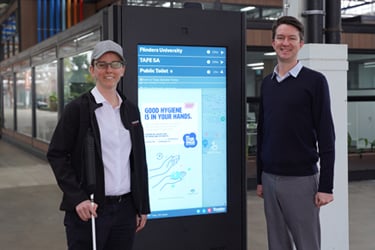Why we're excited about the 5G network and how it will enable Industry 4.0
SAGE Automation, Published: July 9, 2018 - Updated: February 25, 2020 (8 min read)
Australia, and the world, is talking about 5G. A lot.
Its promise of increased speed and unparalleled low latency and throughput capacity has got everyone asking: What does it mean for telecommunications, industry, and the average person with a smart phone?
Some are excited how the 5G network’s ultra-low latency will transform the wireless video and VR experience.
But it goes beyond this.
5G is one of the communication networks from which the major technological disruptors of the century will scale.
We’re talking autonomous vehicles, smart cities, and ‘lights out’ manufacturing – all functions of the Industry 4.0 transformation, now underway across the world.
We explore how the technical specifications of 5G will enable one of the biggest transformations of society since the steam engine…
But first, what is 5G?
5G is the next generation of mobile internet. "Basically, 5G will provide a wider pipeline and faster lanes," says Marc Tracey from US mobile giant Verizon.
Technically speaking 5G is the wireless network and infrastructure that meets the International Telecommunication Union’s (ITU) specifications. These are:
- high data rates (1 Gbps for hotspots, 100 Mbps download and 50 Mbps upload for wide-area coverage)
- massive connectivity (1 million connections per square kilometre)
- ultra-low latency (1 millisecond)
- high reliability (99.999% for mission critical ‘ultra-reliable’ communications), and
- mobility at high speeds (up to 500 km/h i.e. high speed trains).
How does it compare to 1G, 2G, 3G & 4G…?

The 5G network represents more than the standard upgrades we’ve seen with 1G, 2G, 3G and the current 4G services. ITU Secretary-General, Houlin Zhao explains:
[5G] will be the global cornerstone for all activities related to broadband communications and the Internet of Things for the future – enriching lives in ways yet to be imagined.”
Where other upgrades have seen advancements in voice, text and mobile broadband communication, 5G will enable advanced mobile broadband, and importantly: massive machine communications and critical communication applications:
- Massive machine communications refers to connected machines, devices, sensors and analytics platforms and machine learning are optimising manufacturing and process operations.
- Critical communication applications are those that would cause catastrophe if they failed. From autonomous vehicles to automated smart grid energy systems, to medical services that use robotics and virtual reality to operate – a highly reliable wireless service is essential!
But everyone says 4G is fine for these technologies...
Yes, a lot can be realised with 4G – multiple autonomous vehicle (AV) trials are successfully being rolled out using 3G and 4G networks in Australia as we speak.
But while this is adequate for isolated trials, network availability would suffer under current mobile networks if more AVs tried to operate on the same network.
There’s also the question of latency – 4G has never had great response times, and this responsiveness is arguably the most important aspect of critical communication applications.
5G specifications
Network speed & bandwidth
5G is expected to be 50 to 100 times faster than current networks. It could reach speeds of up to 10 gbs per second vs 4Gs maximum 1gb per second and average of 33.76mb per second for normal users.
And, 5G’s increased throughput means the network can handle more at once.
Latency

The time gap between request and response for 5G is expected to be unparalleled. At Telstra’s 5G Innovation Centre on the Gold Coast, recent Ping tests to a Gold Coast server showed 5G latency at 6 milliseconds compared to 20 milliseconds for Telstra’s 4G network.
Low latency is expected to transform autonomous vehicles, manufacturing and industrial processes, medicine, and traffic systems to name a few.
For example, specialist surgeons could operate on someone on the other side of the world via 5G-enabled virtual reality and robot technology, or hundreds of autonomous vehicles could operate on a network that will allow them to react instantaneously.
Availability

A highly availably network is one that can provide high speed connectivity with increased network load AND prioritise reliability and redundancies of such systems. 5G can do all of this.
In practice this would mean supporting an Internet of Things (IoT) ecosystem with redundancies for critical systems such as smart energy grids, autonomous vehicles and real-time sensor data for centralised control centres or geographically dispersed factories.
Network splicing and mesh networks

Network splicing creates tailored sub-networks for Industry 4.0’s various use cases. Image: SDX Central
Network Splicing
Errikson – one of the primary developers of 5G technologies – says one of the biggest technological challenges faced by communication service providers is in delivering a wide variety of network performance characteristics to service future applications.
Network splicing provides the answer. It allows network providers to ‘splice’ their network up into sub-networks that are dedicated to one application or group of users and tailored for their needs, such as latency, security or availability.
For example, an autonomous vehicle network ‘splice’ would feature higher security protocols and latency, while the public broadband network ‘splice’ would require a different set of characteristics.
Mesh networks
Considerable work is being done to make 5G support mesh networks which allow devices to connect and communicate with each other, as well as the network. This interconnection is central to the IoT ecosystem and allowing vehicle-to-vehicle and vehicle-to-infrastructure communication.

Mesh networks will help devices connect with each other. One possible use would be vehicle-to-vehicle (V2V) communication. Source: Michigan Technological University
The 5G landscape: how far away is 5G?

In Australia, the major telcos are still trialling the technology. Telstra and Optus both aim to have their 5G network running in 2019.
But the rollout of 5G infrastructure will be different from other network ‘upgrades’ due to its enablement of disruptive technologies across all industry sectors.
Wirelessweek cautions that, “the emergence of 5G will break down any barriers between network planning and urban planning,” and that “integrated 5G/smart city planning cannot begin too soon.”
If privately owned communications networks are to support the future’s critical infrastructure and services, collaborative governance is essential.
Full realization of the economic growth and cost savings from leveraging Smart City solutions built on 5G infrastructure will depend on how robustly 5G networks are deployed locally, and will require different approaches from those used in the past”– Accenture.
True collaboration will be required if 5G is to live up to the hype.
Telecommunications providers, councils, and the private sector already know this – with numerous smart city consortiums underway across the country.
Industry 4.0 technologies begin and end with data that is captured and stored on dependable communication networks. SAGE works across transport, mining, manufacturing and utilities sectors to bring actionable data insights to its clients. Discover how SAGE’s cloud-based SCADA service delivered remote monitoring across Melbourne Water’s remote below ground assets.









